|
|
The Carrier Markings Of Northern Liberties News Room
Introduction - This is an article that has never appeared in a print journal. It was posted to the net in September, 1999. It presents important new information that shows that the 1835-1836 markings of the Northern Liberties News Room are, in fact, the first United States Carrier markings. Calvet Hahn's assistance is hereby acknowledged and his specific contributions are noted. Since this appeared Mr. Hahn has published an article in the The Chronicle which utilized much of the information first presented here. Introduction added in May, 2000.
May 1, 208 update: A new
letter (#11A) added. Reported by Scott Trepel, Siegel Auction Galleries. It is
addressed to the care of a forwarding agent in New York City, bears a "Hudson's
News Room" forwarding backstamp and is address to Hamburg, Germany.
September 9, 2013 update: A
new earliest reported use has been brought to my attention by Cliff Alexander.
It is docketed as having been written on Oct 4, 1835 (a Sunday) and is
postmarked for carriage to Lawrenceville, N.J. on October 6, 1835. There are no
contents.
Aug 2016 update: Cover #4A added, Type 1 from Evans correspondence, Nov 25
(1835) pmk, ex Charles Stone find
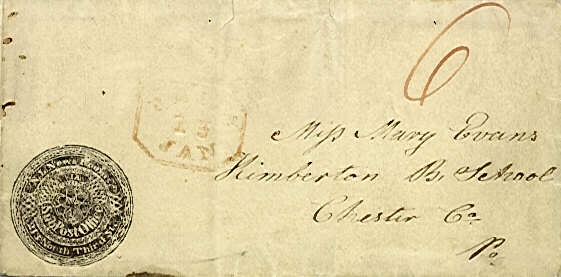
The Northern
Liberties News Room marking on a January 15, 1836 folded letter carried by a
U.S. Carrier to the Philadelphia Post Office.
The unique format markings applied by the Northern Liberties News Room in Philadelphia in 1835 have been somewhat controversial since first discovered and described by Charles H. Stone in an article in the June, 1905 issue of the American Journal of Philately. It has not been a question of authenticity but rather of what exactly these markings represent. Are they government carrier usages, local posts, or something else? Were they hand stamped or printed? Was a metal or a wooden device used?
In my 1990 catalog presentation of the Ambassador J. William Middendorf, II collection of United States carrier and local posts, I first classified these markings as being carrier stamps. Calvet Hahn wrote an article in The Penny Post in January, 1993 that included a survey of the reported covers and correctly challenged my opinion as to how these markings were produced.
I think these important questions can now be answered conclusively as a result of further research conducted by myself and Calvet Hahn and complimented by material found by Ambassador Middendorf and the late Elliot Perry, presented here for the first time. The markings are, in fact, United States carrier markings and they were printed using a wooden device. These markings indicate the prepayment of a postal fee to government appointed mail carrier.
The Northern
Liberties
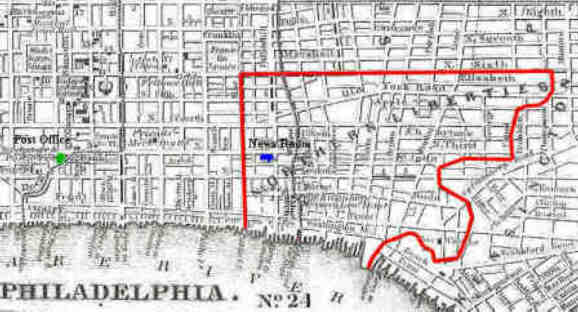
Map of Philadelphia with locations of Post Office and the Northern Liberties News Rooms noted. North is to the right.
The term "Northern Liberties" refers to an area of what is now Philadelphia (the area bounded in red on map above). In 1836 Philadelphia proper extended only to Vine Street. The area north of Vine Street and bounded on the west by Spring Garden and Penn Township and to the east by Kensington was called Northern Liberties. At this time there were approximately 47,000 persons living in the area. The boundary between Philadelphia and Northern Liberties on Vine Street was near several stage offices and the principal hotels of the period including the Bull's Head and the Third Street Hall. Hotels near 3rd and Vine included the Golden Swan, Philadelphia Hotel and the White Swan.
The Northern Liberties News Rooms
The earliest newspaper advertisement that has been found for the Northern Liberties News Rooms appeared in the Philadelphia Saturday Courier issue of March 24, 1833 and announced a free admission news room where "A regular Bulletin or Record of the latest News is kept, where every intelligence of importance is immediately inserted on the arrival of the mails. Strangers are invited to participate in the advantages offered by this establishment." The address was given as "213 N. Third Street, near Callowhill" which was on the east side of the street, in the square just north of Vine Street and a few doors south of the corner of Callowhill. This location was on the southern edge of the Northern Liberties (marked in blue on map above) in the first square north of Philadelphia proper. The exact location is confused because of a house renumbering that has taken place. At this time the Philadelphia post office was located on Dock Street (marked in green on map above), close to 3rd and Walnut, a distance of about three-quarters of a mile from the News Rooms. It should be noted that this was a "free" reading room as opposed to many of the reading rooms in New England that charged an annual fee.
The proprietor of the Northern Liberties News Room was given as "A. McMakin" in an 1835 advertisement that appeared in the DeSilver Philadelphia Directory. Similar advertisements ran in the Saturday Courier from December 26, 1835. The "A. McMakin" referred to was Andrew McMakin who was the proprietor until at least June 4, 1836 when his last advertisement appeared. It is of note to mention that Andrew McMakin and Ezra Holden purchased the Philadelphia Saturday Courier on May 28, 1836 and continued publication for several years.
Another news room, the Irving Free Admission Reading Rooms, James Willding, Proprietor, began advertising in the Saturday Courier in May, 1836 from an address very close to the Northern Liberties News Room at 178 North Third above Vine. Another News Room, at the same address as the Northern Liberties News Room, and now styled "Northern Liberties Free Admission News Rooms" began advertising on November 12, 1836 and listed James M. Young as proprietor.
The Sub-Post Office
The key pieces of information regarding the purpose of the Northern Liberties News Rooms markings can be found in a news item that appeared in the October 10, 1835 issue of the Philadelphia Saturday Courier. This column, reproduced below, includes "The enterprising, attentive and indefatigable proprietor of that popular establishment, the Northern Liberties Free Admission News Room, has found the business of his Sub Post Office so much on the increase, as to induce him to prepare a new and appropriate stamp, which we perceive is now imprinted upon letters deposited at his office.
I should note
that this announcement was first discovered in 1956 when the late Elliot Perry
and Ambassador J. William Middendorf were perusing the newspaper files of the
Pennsylvania Historical Society in an effort to learn more about these markings.
I concur with Perry's unpublished report that "This news item may well be the
first reference to a postage stamp or post office stamp anywhere in the world." This is the first time that this announcement has been published in
the philatelic press.
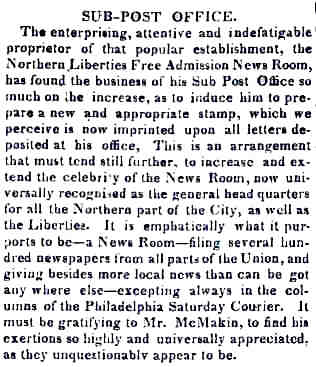
Advertisement for The Northern Liberties News Room from the October 10, 1835 issue of the Philadelphia Courier
In the December 5, 1835 issue of the same newspaper appeared another notice that again refers specifically to the "sub-Post Office" operated by the Northern Liberties News Rooms. It further mentions, probably in reference to the sub Post Office, that "Neither Washington, Baltimore, New York, or Boston, have anything to compare with it."
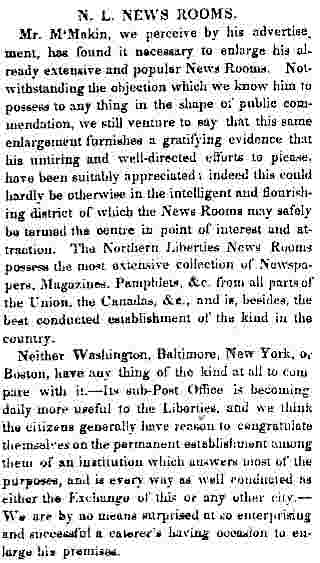
Advertisement for The Northern Liberties News Room from the December 5, 1835 issue of the Philadelphia Courier
Another news item published on January 20, 1836 sheds even more light on the function of a sub Post Office. It is clear from this notice that a "sub-Post Office" was directly linked to the Post Master which must refer to the Philadelphia Post Master. In short, I believe that a "Sub Post Office" at Philadelphia in 1835 referred to a place where letters for delivery to the main Philadelphia Post Office could be deposited and that they would be collected by a regular Philadelphia mail carrier as part of his regular route. That a fee was entailed is apparent from the last sentence which includes "we must come in for our share of the postage money."
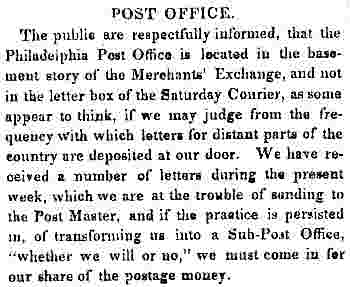
Notice from the January 20, 1836 issue of the Philadelphia Courier.
Northern Liberties Sub Post Office Stamps
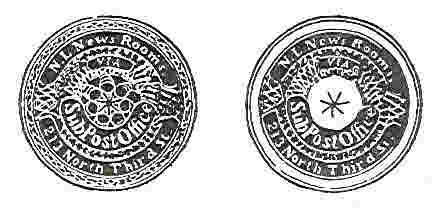
The two types of the Northern Liberties News Rooms marking
There are two known varieties of the Northern Liberties Sub Post Office impression as shown above. Hahn has reported twelve examples of the first (type 1, shown above at left) used between October 9, 1835 and April 5, 1836. I should note that the earliest reported example is a front only that was reported in Philadelphia on October 9, 1835 so that the most likely date of usage is one or two days prior to the postmark date. Another cited example is a piece only. The second type (type II, shown above at right), which was struck from the same device after having a portion of the central ornament removed, is known in four examples dating from May 4, 1836 to May 20, 1836. I record two additional examples of the first type. One (which would be #5A in the Hahn numbering sequence) bears a Philadelphia postmark of December 7 (1835) and is from the original "Evans" correspondence find of seven covers. This may be the same as Hahn lists as December 1, 1835 without further information. The second (which would be #10A in Hahn numbering sequence) is postmarked at Philadelphia on March 6 (1836) and is addressed to Bedford, Pennsylvania. This example bears a paper wrinkle through the impression and was sold as lot #483 in the Richard Frajola, Inc. auction #36 of June 4, 1988. For the Hahn listing of the recorded examples please see the January, 1993 Penny Post article. All of the reported examples are found on mail that entered the Philadelphia Post Office.
The text on the marking reads "N.L. News Rooms, Via Sub Post Office, 213 North Third St." all of which appear as negative lettering contained within an elaborate lathe work design. It is certainly the most elaborate geometric design of any marking found on letters up to the date of usage.
So, what does this marking mean? As to the literal meaning of the words in the marking, I believe that it should be read as "Via the Northern Liberties News Room Sub Post Office (at) 213 North Third Street (to the Philadelphia Post Office)." In the context of the 1836 announcement, I would further define "Sub Post Office" as a place where letters destined for the Philadelphia Post Office could be deposited.
The Government
Carrier Service In Philadelphia In 1835
One of the important
issues in dealing with these stamps is to determine what service was entailed in
their usage. In this regard, the "To the Philadelphia Post Office" portion
of the above reading is important. The letters, already bearing the stamp, could
have been taken by McMakin, or one of his employees, from the sub post office at
the News Rooms to the Post Office in which case they would be properly
classified as local posts. Another possibility is that a Government mail
carrier, attached to the Philadelphia Post Office could have made a regular stop
at the sub post office at the News Rooms to pick up the mail collected there for
delivery to the main Post Office. If this is the case, they would be classified
as Carrier usages.
By 1828 the carrier service was well established in Philadelphia and the directory of that year shows that Philadelphia letter carriers were serving all of the old city from the Delaware River west to Broad Street as well as "the populous parts of the Northern Liberties and Southwark." This would certainly have included an address in the lower section of the Northern Liberties such as that of the News Rooms . During the period before 1840 there were no privately owned local posts in operation anywhere in the United States. The government carrier service evidently provided all of the necessary services relating to carriage of mails both to and from the post office when required.
The DeSilver Directory of 1835 lists seven individuals as letter carriers in Philadelphia. These are: Thomas F. Goodwin, 174 S. 9th, Josiah Johnson, 22 Little George, C.J. Calliday, 289 S. 10th, Samuel Cook, 7th below Noble, Daniel Everly, 107 Dilwin, Henry Hannings, 24 Logan, and Thomas Lloyd at Workmans Court. Calvet Hahn has suggested, in reference to patterns observed in New York City, that carriers usually served in areas near their homes. If such is the case in Philadelphia, the most likely carrier is Daniel Everly at 107 Dilwin. This address is in the Northern Liberties, one block west of North Third, between North Third and North Fourth, and a block closer to Vine Street than the Northern Liberties News Room. This address is less than two blocks from the Northern Liberties News Room.
It seems probable then that McMakin used the words "Sub Post Office" on his stamp to indicate that his News Room was a regular stop and pick up location for the U.S. letter carrier who served that section of the Northern Liberties. Further, the term "Sub Post Office" implies some official connection that would unlikely be used on letters for the government mails unless there was reason to know that the Post Office would not object. No other solution agrees so well with the facts. The carrier fee for service to the post office at this time was most likely two cents per letter.
A United States
Carrier Marking
The designer of the
marking, who sold it, or how it was applied makes no important difference in how
the marking should be classified. If, as the facts indicate, the Northern
Liberties marking represented a fee which a United States letter carrier earned
and received for his official service, then it is a United States carrier stamp.
Local Posts were privately owned and operated and had no official attachment to
the government post office.
A Wooden Device
Was Utilized
In the past I believed
that the actual device used for these markings was made of metal. This
conclusion was based on the great precision of the lathework background lines
and the fineness of the impression. I had suggested John Rakestraw as a possible
printer or engraver based primarily on the similarity to his work that was
utilized for book plates produced for the Northern Liberties News Rooms. George
Sloane and Elliot Perry had suggested the William F. Geddes firm based on
similar lathework appearing in advertisements for the Geddes firm. I am now
convinced, as a result of Calvet Hahn's research which is summarized below,
that the device was actually a wood engraving. It was most likely produced by
William Mason.
The art of wood engraving was practiced by only a handful of men who were located in Philadelphia during the proper period for consideration as makers of the Northern Liberties News Rooms device. George Gilbert and his brother Reuben Gilbert were both active wood engravers in Philadelphia and George is listed in the 1834 City Directory. Other possibilities include R. G. Harrison, Abraham J. Mason, Alva Mason, and William G. Mason.
However, the 1838 "Philadelphia Circulating Business Directory" published by Robert Morris Xylographic Press provides evidence that William S. Mason, 45 Chestnut Street, is the person almost certainly responsible for the Northern Liberties device. This directory illustrated a large number of business cards that include very similar lathework. The cards with the greatest similarities include those for City Hotel, Donahue & Co., W. Marshall, Cary Lea & Blanchard, and Hazen & Thompson. The Morris firm was devoted entirely to printing from wood engravings and, as the wood engraver cited for cards such as those illustrated was William Mason, it seems clear that Mason was the creator of the Northern Liberties device.
That the device was made of wood is further supported by evidence supplied to Calvet Hahn by Eliot Landau. Landau magnified a particularly early impression of the Northern Liberties marking, and others, and noted that the design showed a series of unlinked holes, made by the vessels which carry water and nutrients in trees, that are found in original, end-grain wood surfaces. These characteristics could not be found in an impression made from a metal device. The conclusion is that the device was made from a hardwood such as hickory or boxwood. This would be in keeping with the noted deterioration of the device over the period of usage as well.
The Markings
Were Printed Rather Than Handstamped
The main evidence that the
stamps were printed rather than handstamped is that all reported examples appear
in virtually perfect upright alignment. By this I mean that the "N.L. News
Rooms" portion of the inscription is accurately placed at the top of the
marking without any rotation noticed on any example. If a hand held circular
device, or a seal type device, was used to apply the markings this would be
impossible.
I believe that the most plausible explanation of how these stamps were printed is that they were printed on some sort of hand or foot operated press. The alignment issue suggests a vertical guide for paper feeding was used to assure consistent placement.
The fact that several of the known copies show evidence that the marking was applied after the letter had been folded precludes these having been prepared in advance in a press shop. An impression from a notary seal type device would show evidence of the embossing on the verso which is lacking on all examples studied. The remaining possibility is that they were accomplished using a small, on-premises, card or hand press.
James Moran's "Printing Presses," a 1973 publication of the University of California devotes several pages to miniature, card and proof presses. He reports that in 1834 Holtzappfel & Co. were offering small presses based on the "Stanhope" principle, while T. Cobb was offering a small "Columbian" press for making cards. One of these presses, or a very similar press, seems to be the most likely candidate for having been used to print the Northern Liberties News Rooms stamps.
Markings
Applied Both Before And After Purchase By User
I was fortunate to have
handled the nine examples that were in the Ambassador Middendorf collection as
well as to have had a chance to examine an additional three examples in a
prominent Philadelphia collection. In several of those examples the marking is
placed in exactly the same position when the sheet is unfolded. This would be
almost impossible if the sheets were imprinted after folding by the user.
However, several examples do not conform, and this would only be possible if the
device were struck after folding by the user.
When these markings were
applied is germane to an examination of these markings. Both Cal Hahn and myself
now agree that a least some of the sheets were most likely printed in the
Northern Liberties News Rooms in advance of sale to user. These would have had
the marking impressed on unused lettersheets that were then sold to customers at
a price that included the cost of the carrier service as well as an amount for
the paper itself. Others were probably printed onto the already folded letter
after the sender had sealed the letter. This would most likely have entailed a
different fee which would help explain why no denomination appears in the
marking.
The 1999 Scott
Specialized Catalog illustrates the two markings on page 329 under the heading
of "Local Handstamped Covers." I hope that I have shown, it is neither a
local post nor is it handstamped. In short, it is a press printed United States
carrier marking. As such it represents the earliest such "stamp" issued in
the United States and should be included in the Scott catalog.
Listed by date of arrival
at Philadelphia Post Office. See Hahn listing in Penny Post of January,
1993
Late add-ons:
A1. October 4, 1835, no contents addressed to Mary Clarke, Lawrenceville, NJ, Phila Oct 6 postmark, 10 cents arte (courtesy Cliff Alexander)
1. October 9, 1835, front only
addressed to Reading, Pa.
2. October 28, 1835, addressed to Carlisle, Pa. (ex Middendorf, lot #1)
3. October 31, 1835, addressed to Carlisle, Pa. (ex Jarrett, lot #1200)
4. November 10, 1835, piece only (ex Faulstich, lot #1517)
4A. November 25, 1835
addressed to Mary Evans, Kimberton School
5. December 1, 1835, (Hahn listing, details not known, possibly same as #6)
6. December 7, 1835, Evans correspondence to Chester Co., Pa. (may be same as
#5)
7. January 4, 1836, Evans correspondence (ex Middendorf, lot #3)
8. January 15, 1836, Evans correspondence (ex Middendorf, lot #4)
9. January 31, 1836, addressed to Turbitville. Pa. (ex Hollowbush, lot #87)
10. February 4, 1836, addressed to Clearfield, Pa. (ex Middendorf, lot #5)
11. Febraury 19, 1836, Evans correspondence, (ex Carson)
11A. February 21, 1836,
addressed to Paul A. Oliver, c/o agent in New York
Hudson News Room backstamp and forwarded to Hamburg, Germany (Trepel)
12. March 6, 1836, addressed to Bedford, Pa. (Frajola auction #36)
13. March 14, 1836, addressed to Carlisle, Pa. (ex Meroni)
14. March 31, 1836, addressed to Reading, Pa. (ex Middendorf, lot #6)
15. April 5, 1836, Evans correspondence (Phillips sale of March 11, 1981)
Census Of Reported Type II.
Northern Liberties Covers
1. April 30, 1836, front
only to New York (ex Middendorf, lot #7)
2. May 4. 1836, addressed to Philadelphia (ex Middendorf, lot #8)
3. May 13, 1836, Evans correspondence (Phillips sale of March 11, 1981)
4. May 20, 1836, addressed to Clearfield, Pa. (ex Middendorf, lot #9)
Richard Frajola (Jan 1999, updated May 2018)


